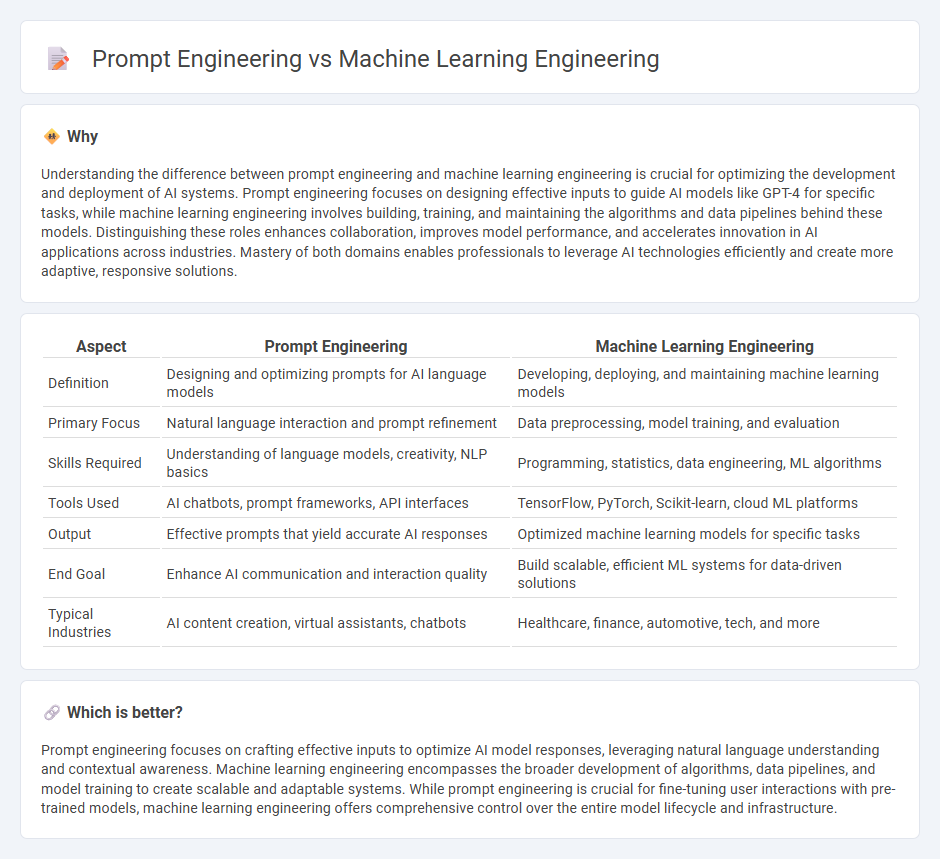
Prompt engineering focuses on designing and refining input prompts to optimize the output of large language models, enhancing their utility in natural language processing tasks. Machine learning engineering involves building, deploying, and maintaining predictive models that learn from data to automate decision-making and improve system performance. Explore deeper distinctions and applications to understand how these engineering roles drive innovation in artificial intelligence.
Why it is important
Understanding the difference between prompt engineering and machine learning engineering is crucial for optimizing the development and deployment of AI systems. Prompt engineering focuses on designing effective inputs to guide AI models like GPT-4 for specific tasks, while machine learning engineering involves building, training, and maintaining the algorithms and data pipelines behind these models. Distinguishing these roles enhances collaboration, improves model performance, and accelerates innovation in AI applications across industries. Mastery of both domains enables professionals to leverage AI technologies efficiently and create more adaptive, responsive solutions.
Comparison Table
| Aspect | Prompt Engineering | Machine Learning Engineering |
|---|---|---|
| Definition | Designing and optimizing prompts for AI language models | Developing, deploying, and maintaining machine learning models |
| Primary Focus | Natural language interaction and prompt refinement | Data preprocessing, model training, and evaluation |
| Skills Required | Understanding of language models, creativity, NLP basics | Programming, statistics, data engineering, ML algorithms |
| Tools Used | AI chatbots, prompt frameworks, API interfaces | TensorFlow, PyTorch, Scikit-learn, cloud ML platforms |
| Output | Effective prompts that yield accurate AI responses | Optimized machine learning models for specific tasks |
| End Goal | Enhance AI communication and interaction quality | Build scalable, efficient ML systems for data-driven solutions |
| Typical Industries | AI content creation, virtual assistants, chatbots | Healthcare, finance, automotive, tech, and more |
Which is better?
Prompt engineering focuses on crafting effective inputs to optimize AI model responses, leveraging natural language understanding and contextual awareness. Machine learning engineering encompasses the broader development of algorithms, data pipelines, and model training to create scalable and adaptable systems. While prompt engineering is crucial for fine-tuning user interactions with pre-trained models, machine learning engineering offers comprehensive control over the entire model lifecycle and infrastructure.
Connection
Prompt engineering and machine learning engineering are interconnected through the development and optimization of AI models, where prompt engineering focuses on designing effective input queries to guide model behavior, and machine learning engineering involves building, deploying, and fine-tuning these models. Both disciplines leverage natural language processing techniques and require a deep understanding of model architecture, training data, and evaluation metrics to enhance performance and reliability. Effective collaboration between prompt engineers and machine learning engineers accelerates innovation in AI applications by improving model interpretability and user interaction efficiency.
Key Terms
**Machine Learning Engineering:**
Machine Learning Engineering involves designing, building, and deploying scalable machine learning models using frameworks like TensorFlow and PyTorch, with a strong emphasis on data preprocessing, feature engineering, and model optimization. It requires proficiency in programming languages such as Python, understanding of algorithms, and knowledge of cloud platforms like AWS or Azure for model deployment. Explore how machine learning engineering drives intelligent applications and transforms data into actionable insights.
Model Training
Machine learning engineering centers on model training through data preprocessing, feature extraction, and algorithm optimization, aiming to develop robust predictive models. Prompt engineering emphasizes crafting specific input prompts to guide pretrained language models, minimizing the need for retraining while maximizing output relevance. Explore more about how these approaches impact AI performance and development strategies.
Feature Engineering
Feature engineering in machine learning engineering involves transforming raw data into meaningful features to improve model accuracy, leveraging techniques like normalization, encoding, and dimensionality reduction. In prompt engineering, the focus shifts to crafting effective input prompts to optimize language model outputs without traditional feature extraction. Explore how these distinct approaches enhance AI performance in dynamic applications.
Source and External Links
What Is a Machine Learning Engineer? (2025 Guide) - Machine Learning Engineers design, build, and maintain self-running AI systems that use large datasets to automate predictive models and optimize learning processes.
Machine Learning Engineering (Andriy Burkov) - The field involves collecting datasets, training statistical models, and deploying these models in production, with an emphasis on scaling, robust code, and continuous monitoring for model degradation.
Machine Learning Engineer Learning Path - Machine Learning Engineers design, build, deploy, optimize, and maintain machine learning systems, often using cloud platforms to handle the full data-to-AI lifecycle from data preparation to model deployment and monitoring.
 dowidth.com
dowidth.com